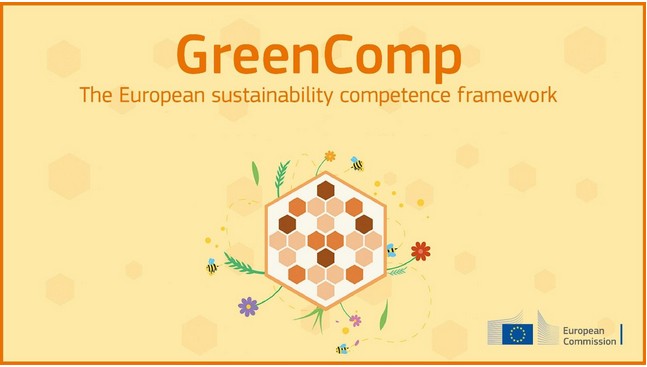In January 2022, the European Commission presented a document which, despite being relatively unknown outside of academic and educational circles, has the potential to transform the way we educate new generations about sustainability.
In January 2022, the European Commission presented a document that has the potential to revolutionise the way we teach sustainability to new generations, although it is still little known outside academic and educational circles.
This is GreenComp: the European Competence Framework for Sustainability. This strategic guide defines the competencies that European citizens, particularly young people, must develop in order to address current and future environmental challenges.
In the face of an ongoing climate emergency, preparing young people to act as agents of change is not just an educational goal — it is a necessity. By articulating knowledge, skills and attitudes geared towards sustainability, GreenComp emerges as a structured and essential response to this urgency.
What is GreenComp and why is it important?
GreenComp is a reference framework created by the European Commission’s Joint Research Centre which organises sustainable competencies into 12 areas grouped into four main dimensions: ‘Embedding sustainability values’, ‘Embracing the complexity of sustainability’, ‘Visualising sustainable futures’, and ‘Acting for sustainability’. Unlike traditional curricula, GreenComp does not prescribe specific content, but rather proposes a set of cross-cutting competencies that can be applied across all disciplines, contexts and stages of life. These range from empathy with other forms of life and the ability to think systemically to intergenerational collaboration, adaptation to change and building positive visions of the future.
These values and skills not only inform, but also transform, the way young people relate to the world.
GreenComp is adaptable and flexible and can be contextualised according to local circumstances. This means that urban or rural schools anywhere in Europe can adopt the proposals while respecting their cultural, environmental and pedagogical specificities.
Why does traditional education fail, and how can GreenComp help address this issue?
For decades, environmental education has been given a low priority in schools, being treated as an extracurricular subject or an isolated activity. Consequently, many young people complete their studies without acquiring the knowledge necessary to address issues such as climate change, water scarcity and responsible consumption.
GreenComp proposes a paradigm shift, suggesting that, rather than addressing sustainability as a separate topic, it should be considered a lens through which all content can be reinterpreted. Mathematics, for instance, could incorporate the critical analysis of CO₂ emissions data and the exploration of statistics and functions. Literature could incorporate ecological narratives, connecting classic works of fiction with reflections on environmental impact. Meanwhile, history can be taught through the relationship between societies and the environment, analysing how industrial revolutions, economic models and land use policies have influenced ecosystems over time. Geography could explore debates on climate change and land use, while the natural sciences could examine the effects of pollution and biodiversity conservation. This approach makes learning more interdisciplinary, showing students that environmental issues are integrated into traditional knowledge.
To implement this approach, teacher training is essential. Many educators still feel unsure about addressing complex issues such as the climate crisis, socio-environmental inequality, and the energy transition. GreenComp offers a framework that supports teachers in this endeavour by promoting interdisciplinary, participatory and real-world project-based approaches.
Will GreenComp be enough to overcome the challenges and criticism?
As with any ambitious project, GreenComp is not immune to criticism. Some argue that the absence of clear, measurable indicators poses an obstacle to its large-scale implementation. Others highlight the risk that, without serious investment in teacher training, curriculum time, dedication and teaching resources, the document will become just another guideline that is ignored.
Another concern relates to uneven implementation. Countries with more resources and a tradition of innovative education tend to progress more quickly, while more conservative or underfunded education systems may fall behind. Widespread implementation will depend on genuine cooperation and tangible investment.
There is always a risk that they will be emptied of meaning, which is a common phenomenon with widely disseminated concepts in public discourse. The term ‘sustainability’, for example, has gradually been incorporated into marketing campaigns and institutional projects that have, in practice, contributed little to concrete change. In many cases, it has become a generic label disconnected from real commitments to environmental, social or economic transformation. The same danger lurks for GreenComp: if it is treated solely as a technical guideline or a bureaucratic requirement, it risks losing its transformative potential.
It is therefore essential that its implementation goes beyond instrumental or ad hoc approaches. GreenComp should not be dismissed as an educational “trend” of the moment but rather recognised as a milestone in the redefinition of contemporary education’s pedagogical objectives. To fulfil its purpose, it must be adopted critically by educators, integrated into public policies and turned into pedagogical practices that promote a genuine culture of sustainability. Implementing GreenComp must be grounded in ethical values, a commitment to intergenerational justice and an in-depth understanding of the complexity of current socio-environmental challenges, while avoiding simplistic approaches that perpetuate utilitarian logics.
An opportunity to rebuild the relationship between young people and the planet
Rather than viewing young people as either the ‘culprits’ of consumption or the ‘saviours’ of the future, GreenComp recognises them as full citizens who have the right to information, participation and meaningful action. This competency framework proposes an educational pathway that recognises their intelligence, potential for change, and leadership skills.
In an era where the ecological crisis is directly impacting everyone’s lives, including young people, through phenomena such as floods, heat waves, food insecurity, and forced migration, GreenComp emerges as a vital resource. It empowers young people to grasp the root causes of these crises and forge collective solutions. Rather than being just an abstract discourse on environmental education, GreenComp transforms this perspective into committed, local, community-based, everyday practice.
If embraced, GreenComp could be a milestone in education, preparing, empowering and inspiring new generations to create the world they want and need.
GreenComp in practice
Although the implementation of GreenComp is still in its early stages in many countries, projects inspired by this initiative are already showing promising results. One such project is GreenComp4Adapt (Green Competences and Civic Engagement in Schools for Adaptation to Climate Change), an Erasmus+ initiative led by IES Botànic Cavanilles in Spain. This European initiative aims to integrate the GreenComp sustainability skills reference framework into secondary education, thereby empowering students and teachers to address climate change through informed education, citizen participation and practical local initiatives. Running from 2024 to 2026, the project will involve schools, educators, and communities from Spain, Portugal, Italy, and the Netherlands.
Three specialised organisations will play a pivotal role in defining strategies for effectively incorporating sustainability skills into school curricula: the Portuguese Association for Environmental Education (ASPEA) in Portugal, the Associació Cultural CRESOL in Spain, and the Associazione Viracão & Jangada APS in Italy. These entities will support the implementation of the project in three participating schools: Escola Secundária Quinta do Marquês in Portugal, Instituto de Educación Secundaria Botànic Cavanilles in Spain, and Stichting Onderwijs Midden Limburg in the Netherlands.
Working directly with schools ensures that the integration of sustainability concepts is tailored to the specific needs of each region. Collaborating with experts in climate change adaptation enriches the curriculum by incorporating scientific knowledge and best practices. This transdisciplinary approach ensures that students receive a comprehensive and meaningful education about the environment.



